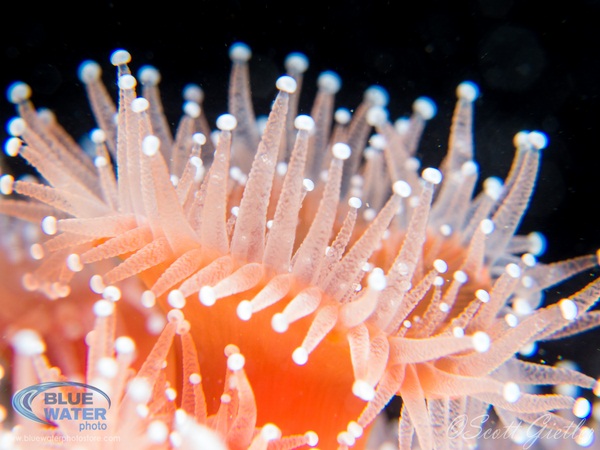Guide to shooting underwater with the Canon G16
March 24th, 2014
Canon G16 - Underwater shooting Guide
Lenses, housings, settings, and more
By Scott Gietler
Why use the Canon G16 for underwater photography?
The Canon G16 is a top of the line compact camera that rivals the Sony RX-100 for focusing speed and image quality. While the Sony RX-100 has a larger sensor, and better color depth and dynamic range, the Canon G16 has a longer lens, better built-in macro capability, and a lower price.
The longer lens lets you get more magnification with a wet lens, and it allows you get to get further back from the subject, which is important to light the subject properly and to not startle it.
When I was testing the G16 underwater, I was impressed by its focusing speed - I thought it was a noticeable improvement from the G12, and rivaled the RX-100 in focusing speed.

Canon G16, no wet lens, dual Sea & Sea YS-D1 strobes, manual strobe power. F6.3, 1/125th, ISO 100
Canon G16 wet lenses
Canon G16 wet macro lenses
For macro - my choice for this lens is the Bluewater +7 macro lens, which is sharp, light, stackable, and gives excellent magnification. The subsee +10 will give a little more magnification (in my tests I didn't notice a big difference), but the Nauticam supermacro converter will give the most magnification with the least amount of corner softness.

Canon G16 underwater photo, taken with the Bluewater +7 macro lens. F8, 1/1000th, ISO 100
Flip adapter holders
For the Canon brand housing, the iDas flip adapter with the Bluewater +7 macro lens will give excellent results.
For the Nauticam housing, I'd recommend either the iDas flip adapter or the better built Nauticam flip diopter holder.

Canon G16 with Nauticam supermacro converter
Canon G16 wet wide-angle lenses
For the Canon, Fantasea, Ikelite, and Nauticam housings we recommend a new G-series wide-angle lens that we have, that gives very good results, much wider than the G16 without a wide-angle lens.
For the widest "wet lens" option, you would want the Nauticam G16 housing with both the Inon S100ZM80 lens, and the Inon S100ZM80 dome unit.
Canon G16 "dry" wide-angle lenses
For the Recsea G16 housing, the UWL-04 fisheye lens with included G16 port adapter is highly recommended. This is the best wide-angle lens for the G16, but the lens must be changed on land.

Canon G16 underwater photo with Bluewater wide-angle G-series lens. F4, 1/125th, ISO 100
Canon G16 settings
For macro and supermacro, I like to start at F8, 1/1000th, ISO 100. This does a good job of blocking out the ambient light. For wide-angle, I'll shoot at F6.3, 1/125th, ISO 100 - but these settings can change considerable depending on the ambient light available, or if the sun is in the photo. We do recommend shooting at F6.3 - F8 when using a wide-angle lens for sharper corners.
AF-point zoom is a really nice feature when shooting macro, turn it on in the shooting menu (3rd menu item). It shows you a magnified zoom of the center when focusing.
I like shooting n RAW, auto-white balance, spot focus mode, center weighted metering, AF-assist beam off.
More details on settings can be found here.

Canon G16 underwater photo, with Bluewater G-series wide-angle lens. F6.3, 1/100th, ISO 100
Canon G16 housing selection
Having seen so many floods happen in the Canon brand housing, it is difficult to recommend it when the Fantasea G16 housing is so much better. The Fantasea housing is quite a good value, as it is a good quality housing and the controls work fairly well.
The Ikelite G16 housing for $650 makes sense if you use Ikelite strobes, because you can utilize their excellent TTL system, although the housing is larger than the other housings.
The Nauticam 16 housing and Recsea G16 housing are both high-quality aluminum housings with the best ergonomics of any of the housings. The Nauticam housing has a leak detector and a 67mm threaded port, making it ideally for use with a flip-diopter for macro. The Recsea has a rear control dial that is easy to use with thick gloves, and the port can be swapped on land for a UWL-04 fisheye lens, making it a good choice for the widest possbile wide-angle solution.
Conclusion
For underwater photographers who want a very small setup and want to focus on macro, the G16 is an excellent choice. In addition, good to great wide-angle options are available




